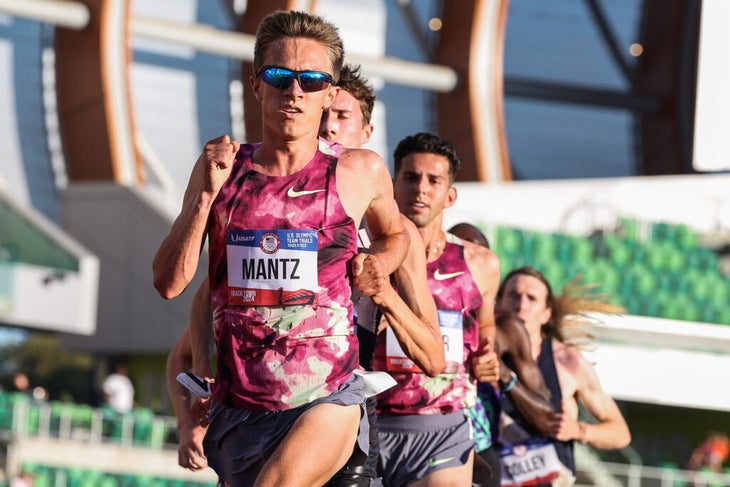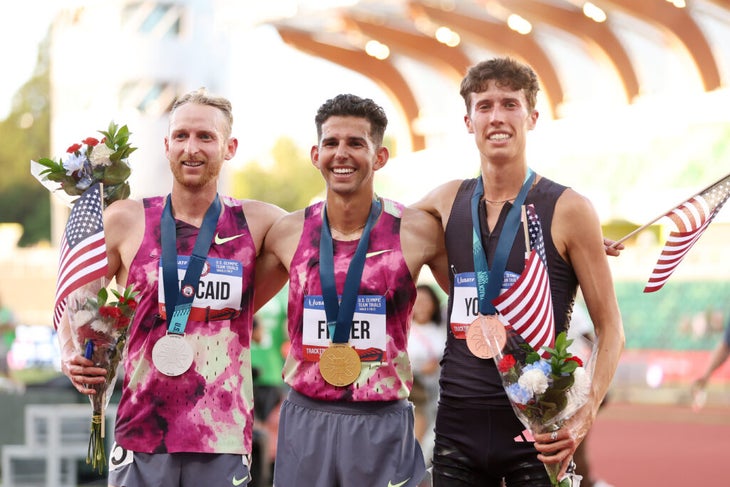“], “filter”: { “nextExceptions”: “img, blockquote, div”, “nextContainsExceptions”: “img, blockquote, a.btn, a.o-button”} }”>
New perk: Easily find new routes and hidden gems, upcoming running events, and more near you. Your weekly Local Running Newsletter has everything you need to lace up!
>”,”name”:”in-content-cta”,”type”:”link”}}”>Subscribe today.
On Friday evening in Eugene, Oregon, the present, the past, and the future of U.S. men’s distance were on full display in a captivating men’s 10,000-meter final at the U.S. Olympic Trials.
In most events at the June 21-30 Olympic Trials, the top three finishers will earn a spot on Team USA and get the chance to run in the Paris Olympics later this summer. But in the men’s 10,000 meters, only three runners going into the meet had secured the Olympic-qualifying standard—Grant Fisher, Woody Kincaid, and Nico Young. So it was perhaps anticlimactic that Fisher, Kincaid, Young was the eventual order of finish in the race. But it’s how the 25-lap race played out in a unique shape-shifting jumble of paces and lead changes that made it so compelling to watch, so hard to run, and also why it gives fans of American distance running plenty of reasons to be optimistic about this summer and beyond.
Despite the fluctuations, there was little surprise in the final results. After 22 laps of alternating paces among several race leaders, Fisher took charge with three laps to go, ripping off consecutive laps of 62.3, 60.4, and 58.1 seconds to blow the race open and win in 27:49.47.
The victory was the first U.S. 10,000-meter title for the 27-year-old Nike-sponsored runner, who left the Bowerman Track Club last fall and moved from Portland, Oregon, to Park City, Utah, to train under the guidance of his former Michigan high school coach Mike Scannell.
“My plan was to go to the front with 1200 meters to go and press,” said Fisher, who finished fifth in the event in the Tokyo Olympics and lowered the American record to 26:33.84 in 2022. “I know I’m good off a fast pace. If I leave it down to a final 400-meter sprint, it’s a bit more of a tossup because I know Woody has really good speed, Paul Chelimo has really good speed, and Nico has really good speed. I knew I could control the outcome a lot more if I went early, so that’s what I did.”
RELATED: How to Watch the U.S. Olympic Trials
Mantz Charges to the Front
Long before Fisher turned in a furious kick to secure his second straight Olympic berth, the near-capacity crowd at Hayward Field was treated to a spicy up-tempo effort from Conner Mantz, who will be running the Olympic marathon for the U.S. in Paris on August 10. Mantz said he earnestly entered the 10,000 with the hopes of finishing in the top three. He went right to the front with the hard-charging style he’s been known for well before he turned pro three years ago.
The 27-year-old Mantz burst out to a 4:18 opening mile and continued to string the field out—despite a brief half-lap surge on lap 11 from Chelimo, a two-time Olympic medalist in the 5,000 meters—by going through the 5K in 13:44. Mantz retook the lead after Chelimo’s 200-meter spurt and continued to spearhead a six-runner breakaway pack, but at some point he said he began wondering—just as most of the crowd probably was—what he was doing up there running so hard. He said he considered dropping out, but instead slowed up quite a bit, bringing a pack of 10 runners back together for a lap.

But then, with about 10 laps to go, 39-year-old Sammy Chelanga, surprised the field with a big surge and strung out the field again, briefly showing the old form he ran with 14 years ago when he set a collegiate record in the 10,000 meters. Mantz faded into the lead pack for good, although he stayed in the race and kicked hard to finish sixth in 28:00.90.
“It’s a goal of mine to be top three at one of these things, and I came into this race with nothing to lose because I’m still an Olympian no matter what happens,” Mantz said. “So the goal was to get a good race in and push the pace and try to finish in the top three. But while there was nothing to lose, there wasn’t really anything to gain, either, other than personal pride. I had thought about dropping out at 5K, but I talked myself out of that and kept running.”
That collegiate record Chelanga had set way back when remains his personal best (27:08.39), but the record was lowered to 26:52.72 in March by Young, a 21-year-old Northern Arizona University runner who seems to be the next great American distance runner in waiting. As Chelanga was leading the race on Friday night, Young, who just capped a solid collegiate career with two NCAA indoor titles and a runner-up showing in the NCAA 5,000 meters two weeks ago on the same track in Eugene, was running right behind him in his first Olympic Trials race. Running with a keen sense of urgency, Young threw in his own surge, passing Chelanga and taking the lead with five laps to go.
Young’s burst didn’t last long, though, because the 33-year-old Chelimo, trying to rekindle his glory from the 2016 and 2020 U.S. Olympic Trials, made one last valiant move into the lead. But that was quickly erased when Andrew Colley, another 33-year-old runner with a decade of professional running under his belt, moved to the front with with a mile to go and threw down a faster, 64.9-second lap.
Related: What You Need to Know About the U.S. Olympic Trials
Fisher Takes Charge
As Colley strung out the field once again, Fisher moved up on his heels and was ready to seize the moment. Kincaid, a longtime training partner of Fisher, sensed it was coming and fell in line. Young, admittedly running on fumes at that point, did his best to hold on. Fisher’s dramatic move with three laps to go made the crowd roar, and after two strong laps, he’d opened a four-second lead over Kincaid and Young by the bell lap.
With the crowd on its feet, Fisher cruised to the final circuit to the finish, followed by a fast-closing Kincaid (27:50.74), who earned his second straight Olympic team berth, and Young (27:52.40), who was barely able to hold-off a sprinting Drew Hunter (27:53.35) for third place to seal the first Olympic opportunity of his budding career.
“It feels really good,” Fisher said after the win. “There’s a lot of anticipation going into the trials. You never know what’s going to happen.”
It marked a return to the top of the podium for Fisher and Kincaid, who were teammates and training partners for four years as members of the Nike Bowerman Track Club in Portland from 2019-2022.
Kincaid won the 10,000 at the Covid-delayed U.S. Olympic Trials in 2021 and finished 15th in the event at the Tokyo Olympics (and also 14th in the 5,000). But after an off-year in 2022, he left the Nike-sponsored Bowerman program (and coach Jerry Schumacher) and moved in early 2023 to Flagstaff, Arizona, to train under NAU coach Mike Smith, who also happens to coach Young.
Fisher, meanwhile, had placed fifth in the 10,000 and ninth in the 5,000 at the Tokyo Olympics, then was fourth and sixth, respectively, in those events at the 2022 world championships in Eugene. Last year, he finished a disappointing fourth in the 10,000 at the U.S. championships—missing the opportunity to run in the world championships in Budapest—but rebounded to break the American record in the 3,000 before announcing his departure from the Bowerman program and move to Utah.
Training under Smith in Flagstaff, Kincaid returned to form and won the 10,000 at last year’s U.S. championships and then wound up 11th at last year’s world championships. He and Young didn’t train together much this spring, in part because Kincaid was dinged up with an undetermined leg injury for about 10 days in April and had to ease up on his training.
While he was challenged by the yo-yo-ing changes in the race, he was happy to run strong enough in Fisher’s wake to make Team USA once again.
“That was a weird race, but it always is,” Kincaid said. “Did it play out like I thought it would? That was a scenario we talked about, knowing Grant would maybe go early if there’s four people left. If there was only three people left, we probably could have waited until the last lap. It wasn’t an easy way to run with all of the changes, but it’s never easy to make the Olympic team.”
The Present and the Future
While time is running out on Chelanga, Chelimo, and Colley, Fisher and Kincaid—and Mantz, of course—still clearly represent the present of American distance running, and Young definitely appears to be the future.

“I knew that when Grant went, that was when the race was really gonna begin,” Young said. “So when he went and no one kind of matched it, I kind of felt like I had to go, otherwise I was gonna miss my shot, so that’s what I tried to do. I didn’t feel as good as I wanted to, but it was good enough for today.”
Needless to say, it was an enticing way to conclude the hot first day of competition at the 10-day Olympic Trials, which will determine Team USA in Paris.
RELATED: After Double Knee Surgery, This Runner is Poised to Make Team USA for the Paris Olympics
